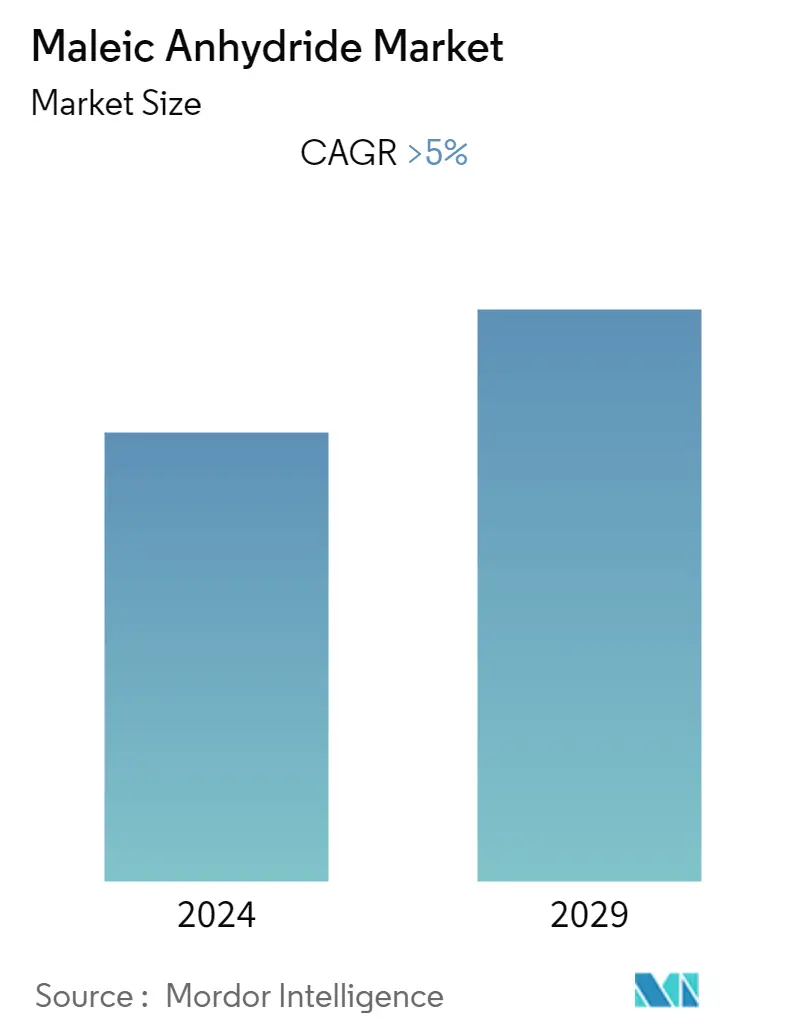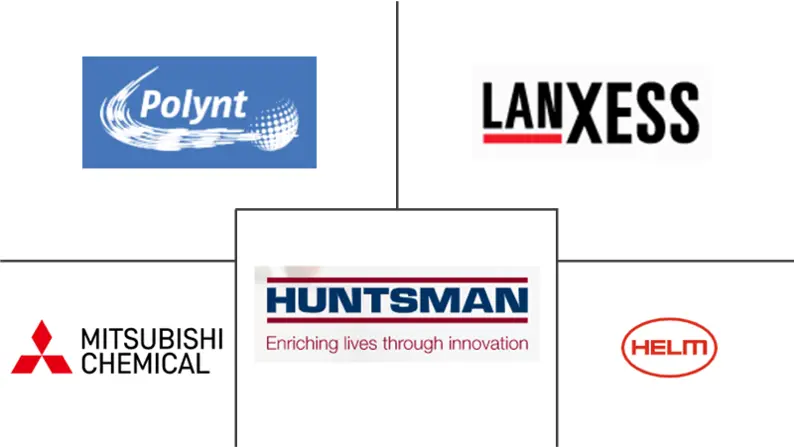Market Size of Maleic Anhydride Industry

| Study Period | 2019 - 2029 |
| Base Year For Estimation | 2023 |
| CAGR | 5.00 % |
| Fastest Growing Market | Asia Pacific |
| Largest Market | Asia Pacific |
| Market Concentration | Low |
Major Players
*Disclaimer: Major Players sorted in no particular order |
Maleic Anhydride Market Analysis
The global maleic anhydride market is projected to register a CAGR of over 5% during the forecast period.
The COVID-19 pandemic in 2020 and the first half of 2021 affected various sectors, including maleic anhydride-producing industries. The maleic anhydride market showed negative growth as it was affected by disruptions in the global supply chain, the fluctuation of oil prices, and curtailed downstream demand. However, the market registered steady growth, owing to increased automotive and industrial activities in the second half of 2021.
- Over the short term, the rising global demand for unsaturated polyester resin and the growth of end-user industries in emerging nations are major factors driving the growth of the market studied.
- However, increasing government regulations regarding the handling and application of maleic anhydride are a key factor anticipated to restrain the growth of the target industry over the forecast period.
- Still, the commercialization of bio-based maleic anhydride is likely to give the global market some good chances for growth in the near future.
- Asia-Pacific is estimated to witness healthy growth over the assessment period in the maleic anhydride market due to the wide usage of maleic anhydride in end-use application segments, such as automotive, construction, and other industries.
Maleic Anhydride Industry Segmentation
Maleic anhydride is a colorless or white solid, cyclic dicarboxylic anhydride with the chemical formula C2H2(CO)2O that can be produced from vapor-phase oxidation of n-butane. It is a highly reactive chemical intermediate, majorly used to produce unsaturated polyester resin and in the formulation of coatings, surfactants, plastic additives, pharmaceuticals, and others. The maleic anhydride market is segmented by product type, end-user industry, and geography. By product type, the market is segmented into unsaturated polyester resin, 1,4-Butanediol (BDO), lubricant additives, maleic anhydride copolymers, malic acid, fumaric acid, alkyl succinic anhydrides, surfactants and plasticizers, and other product types. By end-user industry, the market is segmented into construction, automobile, food and beverage, oil products, electronics, personal care, pharmaceuticals, and agriculture. The report also offers the market size and forecasts for the maleic anhydride market in 15 countries across the major regions. For each segment, the market sizing and forecasts have been done on the basis of revenue (in USD million).
| Product Type | |
| Unsaturated Polyester Resin | |
| 1,4-Butanediol | |
| Lubricant Additives | |
| Maleic Anhydride Copolymers | |
| Malic Acid | |
| Furmaric Acid | |
| Alkyl Succinic Anhydrides | |
| Surfactants and Plasticizers | |
| Other Product Types |
| End-user Industry | |
| Construction | |
| Automobile | |
| Food and Beverage | |
| Oil Products | |
| Electronics | |
| Personal Care | |
| Pharmaceuticals | |
| Agriculture |
| Geography | |||||||
| |||||||
| |||||||
| |||||||
| |||||||
|
Maleic Anhydride Market Size Summary
The maleic anhydride market is poised for significant growth, driven by increasing global demand for unsaturated polyester resins and the expansion of end-user industries in emerging markets. Despite the initial setbacks caused by the COVID-19 pandemic, which disrupted supply chains and led to fluctuating oil prices, the market has rebounded with steady growth due to heightened automotive and industrial activities. The Asia-Pacific region, particularly China, is expected to witness robust growth, fueled by its booming construction sector and rising demand for automobiles, electronics, and personal care products. However, the market faces challenges from stringent government regulations regarding the handling and application of maleic anhydride, which could potentially hinder its growth trajectory.
Maleic anhydride is a crucial raw material in the production of unsaturated polyester resins, which are extensively used in creating fiberglass composites for various applications, including automotive, construction, and consumer products. The expansion of the building and construction industry, driven by urbanization and population growth, has significantly boosted the demand for these resins. In addition, the commercialization of bio-based maleic anhydride presents new growth opportunities for the market. Key players in the industry, such as Huntsman Corporation, Polynt, LANXESS, HELM AG, and Mitsubishi Chemical Corporation, are actively expanding their production capacities to meet the growing demand, particularly in the automotive and electrical sectors.
Maleic Anhydride Market Size - Table of Contents
-
1. MARKET DYNAMICS
-
1.1 Drivers
-
1.1.1 Rising Global Demand for Unsaturated Polyester Resin
-
1.1.2 Growth of End-user Industries in Emerging Nations
-
-
1.2 Restraints
-
1.2.1 Increasing Government Regulations
-
-
1.3 Industry Value Chain Analysis
-
1.4 Porter's Five Forces Analysis
-
1.4.1 Bargaining Power of Suppliers
-
1.4.2 Bargaining Power of Consumers
-
1.4.3 Threat of New Entrants
-
1.4.4 Threat of Substitute Products and Services
-
1.4.5 Degree of Competition
-
-
-
2. MARKET SEGMENTATION (Market Size in Value)
-
2.1 Product Type
-
2.1.1 Unsaturated Polyester Resin
-
2.1.2 1,4-Butanediol
-
2.1.3 Lubricant Additives
-
2.1.4 Maleic Anhydride Copolymers
-
2.1.5 Malic Acid
-
2.1.6 Furmaric Acid
-
2.1.7 Alkyl Succinic Anhydrides
-
2.1.8 Surfactants and Plasticizers
-
2.1.9 Other Product Types
-
-
2.2 End-user Industry
-
2.2.1 Construction
-
2.2.2 Automobile
-
2.2.3 Food and Beverage
-
2.2.4 Oil Products
-
2.2.5 Electronics
-
2.2.6 Personal Care
-
2.2.7 Pharmaceuticals
-
2.2.8 Agriculture
-
-
2.3 Geography
-
2.3.1 Asia-Pacific
-
2.3.1.1 China
-
2.3.1.2 India
-
2.3.1.3 Japan
-
2.3.1.4 South Korea
-
2.3.1.5 Rest of Asia-Pacific
-
-
2.3.2 North America
-
2.3.2.1 United States
-
2.3.2.2 Canada
-
2.3.2.3 Mexico
-
-
2.3.3 Europe
-
2.3.3.1 Germany
-
2.3.3.2 United Kingdom
-
2.3.3.3 France
-
2.3.3.4 Italy
-
2.3.3.5 Rest of Europe
-
-
2.3.4 South America
-
2.3.4.1 Brazil
-
2.3.4.2 Argentina
-
2.3.4.3 Rest of South America
-
-
2.3.5 Middle-East and Africa
-
2.3.5.1 South Africa
-
2.3.5.2 Saudi Arabia
-
2.3.5.3 Rest of Middle-East and Africa
-
-
-
Maleic Anhydride Market Size FAQs
What is the current Maleic Anhydride Market size?
The Maleic Anhydride Market is projected to register a CAGR of greater than 5% during the forecast period (2024-2029)
Who are the key players in Maleic Anhydride Market?
Huntsman International LLC, HELM AG, Mitsubishi Chemical Corporation, LANXESS and Polynt are the major companies operating in the Maleic Anhydride Market.

